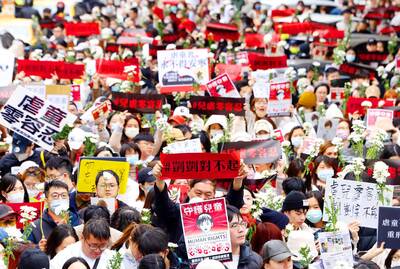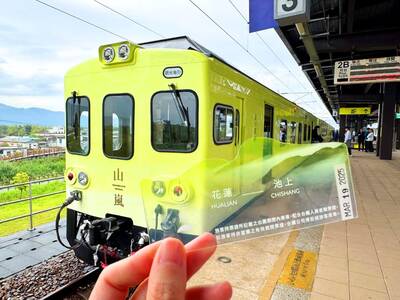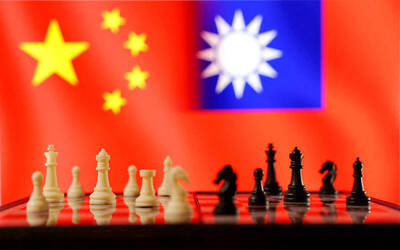That morning commute can be a real killer -- in more ways than one.
Atmospheric science researchers armed with scientific equipment sampled the air on the streets and on the mass rapid transit (MRT) system in Taipei and discovered that commuters were breathing in four to five times more dangerous particles than normal levels.
Levels of particle matter below 2.5 micrometers in diameter -- or PM2.5 -- and carcinogenic polycyclic aromatic hydrocarbons (PAHs) were highest in the morning and scooter riders stuck in traffic were the most exposed.
"A major source of PM2.5 is engine exhaust," said Lung Shih-chun (龍世俊), associate research fellow at Academia Sinica's Center for Environmental Changes.
"The closer you get to traffic, the higher the concentration of fine particular matter and harmful hydrocarbon compounds," Lung said.
The samplings were taken in 2004 and 2005 between two MRT stations in Taipei.
Lung cited the "Six Cities" study conducted in 1993, which showed a strong correlation between exposure to PM2.5 and cardiovascular and lung-related deaths.
"Fine particulate matters are not filtered out by our body but are breathed deep into the lungs," she said.
The study showed that on average scooter drivers were exposed to PM2.5 concentrations of 161 micrograms per cubic meter during their daily commute, substantially more than the 90 micrograms per cubic meter for car drivers and 105 micrograms per cubic meter for people riding on the MRT.
"We could see the concentrations spike at traffic lights, with scooter riders sitting behind the idling engines of the vehicles in front of them," she said.
Scooter riders were also most vulnerable to PAHs, another component of engine exhaust and a highly potent carcinogen.
The study found that scooter riders are exposed to PAH concentrations of 29 nanograms per cubic meter, compared to 8 nanograms per cubic meter for car drivers.
The PAH concentration on the MRT, meanwhile, was below detectable levels, Lung said.
Although the study did not follow bus commuters, Lung said exposure levels were likely to be between that of car drivers and scooter riders because of the frequent opening of bus doors and long waits at bus stops.
Cyclists were likely the worst off as exercising increases the volume of oxygen breathed in, she said.
The levels of fine particulate matter, including PAHs, were consistently more serious in the mornings as there is less air movement, Lung said, adding that sunlight later on helps clear up some pollutants, which tend to be trapped close to the ground.
For people who continue to ride their scooters and bicycles, Lung said face masks were advisable.
"My previous research showed that even the cheap cotton masks block more than a third of fine particulate matter," she said.

Taiwan yesterday condemned the recent increase in Chinese coast guard-escorted fishing vessels operating illegally in waters around the Pratas Islands (Dongsha Islands, 東沙群島) in the South China Sea. Unusually large groupings of Chinese fishing vessels began to appear around the islands on Feb. 15, when at least six motherships and 29 smaller boats were sighted, the Coast Guard Administration (CGA) said in a news release. While CGA vessels were dispatched to expel the Chinese boats, Chinese coast guard ships trespassed into Taiwan’s restricted waters and unsuccessfully attempted to interfere, the CGA said. Due to the provocation, the CGA initiated an operation to increase

A crowd of over 200 people gathered outside the Taipei District Court as two sisters indicted for abusing a 1-year-old boy to death attended a preliminary hearing in the case yesterday afternoon. The crowd held up signs and chanted slogans calling for aggravated penalties in child abuse cases and asking for no bail and “capital punishment.” They also held white flowers in memory of the boy, nicknamed Kai Kai (剴剴), who was allegedly tortured to death by the sisters in December 2023. The boy died four months after being placed in full-time foster care with the

The Shanlan Express (山嵐號), or “Mountain Mist Express,” is scheduled to launch on April 19 as part of the centennial celebration of the inauguration of the Taitung Line. The tourism express train was renovated from the Taiwan Railway Corp’s EMU500 commuter trains. It has four carriages and a seating capacity of 60 passengers. Lion Travel is arranging railway tours for the express service. Several news outlets were invited to experience the pilot tour on the new express train service, which is to operate between Hualien Railway Station and Chihshang (池上) Railway Station in Taitung County. It would also be the first tourism service

‘MALIGN PURPOSE’: Governments around the world conduct espionage operations, but China’s is different, as its ultimate goal is annexation, a think tank head said Taiwan is facing a growing existential threat from its own people spying for China, experts said, as the government seeks to toughen measures to stop Beijing’s infiltration efforts and deter Taiwanese turncoats. While Beijing and Taipei have been spying on each other for years, experts said that espionage posed a bigger threat to Taiwan due to the risk of a Chinese attack. Taiwan’s intelligence agency said China used “diverse channels and tactics” to infiltrate the nation’s military, government agencies and pro-China organizations. The main targets were retired and active members of the military, persuaded by money, blackmail or pro-China ideology to steal